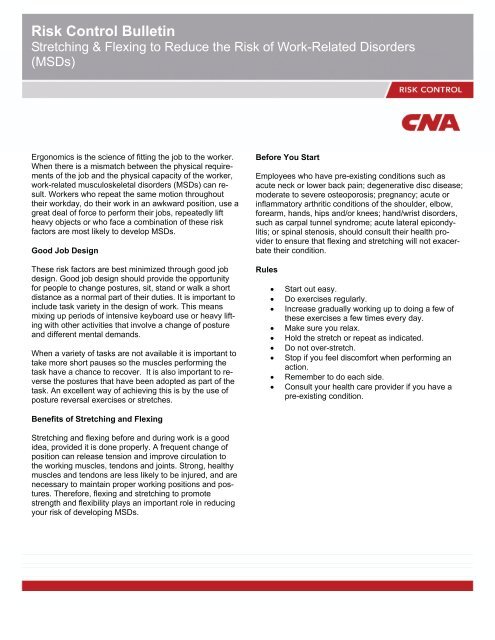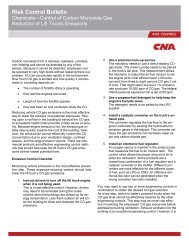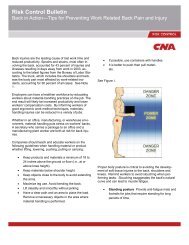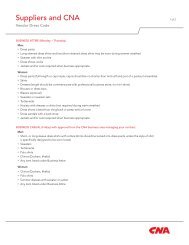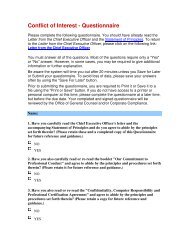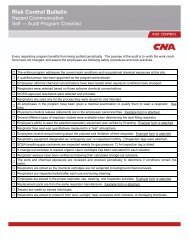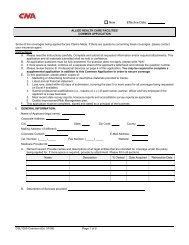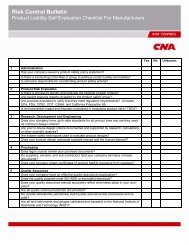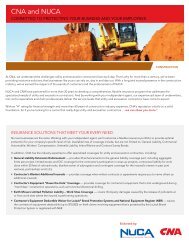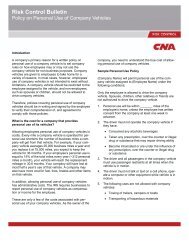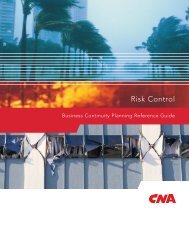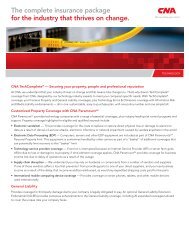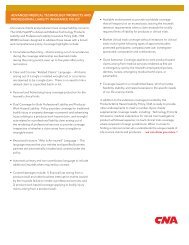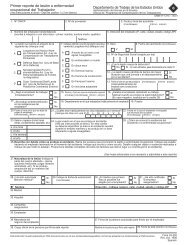Stretching and Flexing - CNA
Stretching and Flexing - CNA
Stretching and Flexing - CNA
- No tags were found...
You also want an ePaper? Increase the reach of your titles
YUMPU automatically turns print PDFs into web optimized ePapers that Google loves.
Risk Control Bulletin<strong>Stretching</strong> & <strong>Flexing</strong> to Reduce the Risk of Work-Related Disorders(MSDs)Ergonomics is the science of fitting the job to the worker.When there is a mismatch between the physical requirementsof the job <strong>and</strong> the physical capacity of the worker,work-related musculoskeletal disorders (MSDs) can result.Workers who repeat the same motion throughouttheir workday, do their work in an awkward position, use agreat deal of force to perform their jobs, repeatedly liftheavy objects or who face a combination of these riskfactors are most likely to develop MSDs.Good Job DesignThese risk factors are best minimized through good jobdesign. Good job design should provide the opportunityfor people to change postures, sit, st<strong>and</strong> or walk a shortdistance as a normal part of their duties. It is important toinclude task variety in the design of work. This meansmixing up periods of intensive keyboard use or heavy liftingwith other activities that involve a change of posture<strong>and</strong> different mental dem<strong>and</strong>s.When a variety of tasks are not available it is important totake more short pauses so the muscles performing thetask have a chance to recover. It is also important to reversethe postures that have been adopted as part of thetask. An excellent way of achieving this is by the use ofposture reversal exercises or stretches.Before You StartEmployees who have pre-existing conditions such asacute neck or lower back pain; degenerative disc disease;moderate to severe osteoporosis; pregnancy; acute orinflammatory arthritic conditions of the shoulder, elbow,forearm, h<strong>and</strong>s, hips <strong>and</strong>/or knees; h<strong>and</strong>/wrist disorders,such as carpal tunnel syndrome; acute lateral epicondylitis;or spinal stenosis, should consult their health providerto ensure that flexing <strong>and</strong> stretching will not exacerbatetheir condition.Rules• Start out easy.• Do exercises regularly.• Increase gradually working up to doing a few ofthese exercises a few times every day.• Make sure you relax.• Hold the stretch or repeat as indicated.• Do not over-stretch.• Stop if you feel discomfort when performing anaction.• Remember to do each side.• Consult your health care provider if you have apre-existing condition.Benefits of <strong>Stretching</strong> <strong>and</strong> <strong>Flexing</strong><strong>Stretching</strong> <strong>and</strong> flexing before <strong>and</strong> during work is a goodidea, provided it is done properly. A frequent change ofposition can release tension <strong>and</strong> improve circulation tothe working muscles, tendons <strong>and</strong> joints. Strong, healthymuscles <strong>and</strong> tendons are less likely to be injured, <strong>and</strong> arenecessary to maintain proper working positions <strong>and</strong> postures.Therefore, flexing <strong>and</strong> stretching to promotestrength <strong>and</strong> flexibility plays an important role in reducingyour risk of developing MSDs.
2TitleNecksChin TuckShoulders And BacksShoulder ShrufSit straight <strong>and</strong> bring shoulders up towards ears. Hold for3 seconds. Relax. Repeat twice.Arm CirclesRaise the head to straighten the neck. Tuck the chin in<strong>and</strong> downwards creating a double chin. Hold for 10 seconds<strong>and</strong> repeat several times.Head TurnsClose eyes <strong>and</strong> very slowly turn head to look over leftshoulder <strong>and</strong> hold for 10 seconds. Turn head the otherway <strong>and</strong> hold for 10 seconds. Repeat 5 to 10 times.St<strong>and</strong> with arms raised horizontally <strong>and</strong> slightly in front ofshoulders, palms down, <strong>and</strong> feet shoulder-width apart.Rotate arms in forward circular motion for 15 seconds.Relax. Repeat sequence three or four times.Note: Those with acute neck pain, degenerative disc diseaseor moderate to severe osteoporosis should consulttheir physician before doing this exercise.2
3TitleCable StretchShoulder StretchSit up straight <strong>and</strong> imagine you have a cable attached tothe top of your head. Feel the cable slowly pull you uphigher <strong>and</strong> higher. Hold a few seconds. Relax <strong>and</strong> repeat3 times.Reach for the SkyPut your h<strong>and</strong>s up, with forearms raised. Push your armsback, squeezing your shoulder blades. Hold for a few seconds.Relax <strong>and</strong> repeat 3 times.Note: Those with acute inflammatory or arthritic conditionsof the shoulder should consult their physician beforedoing this exercise.Execute <strong>Stretching</strong>Raise h<strong>and</strong>s over head, stretching as high as possible.Then bring arms back down. Rest <strong>and</strong> repeat twice.Sit upright with your h<strong>and</strong>s clasped behind your head.Lean back into chair. Gently pull your elbows back as faras you can. Hold for 3 seconds. Relax <strong>and</strong> repeat twice.Note: Those with acute neck pain or inflammatory or arthriticconditions of the shoulder should consult their physicianbefore doing this exercise.3
4TitleBackward Shoulder RollsLegs And FeetHip <strong>and</strong> Knee RockRotate both shoulders backwards keeping arms relaxed<strong>and</strong> by sides. Repeat 3 to 5 times.Disc RelieverSt<strong>and</strong> with your h<strong>and</strong>s on your hips. Place feet apart <strong>and</strong>rock from side to side, bending alternate knees. Repeat10 to 20 times.Note: Those with arthritic conditions of the hips <strong>and</strong>/orknees should consult their physician before doing thisexercise.Foot RotationSt<strong>and</strong>ing up straight with feet slightly apart, place h<strong>and</strong>sin hollow of back. Focus eyes on a point straight ahead.Bend backwards over h<strong>and</strong>s without bending knees, <strong>and</strong>then straighten up. Repeat 10 times.While seated, hold onto the chair with h<strong>and</strong>s on eitherside. Straighten leg <strong>and</strong> lift foot a few inches off floor. Rotatefoot <strong>and</strong> ankle both ways (point toes up) <strong>and</strong> extend(point toes down). Repeat several times per foot.Note: Those with degenerative disc disease, acute lowerback pain, spinal stenosis, or pregnant women shouldconsult their physician before doing this exercise.4
5TitleFoot PressWrist FlexSitting erect in chair, press down alternately with ball <strong>and</strong>heel of right foot several times. Repeat with left foot.Arms And H<strong>and</strong>sFinger StretchPut your right elbow on a table or desk, with your h<strong>and</strong>raised. With your left h<strong>and</strong>, gently bend your right h<strong>and</strong>back toward your forearm. Hold for 5 seconds. Relax. Repeaton the other side.Note: Those with acute inflammatory or arthritic conditionsof the elbow or forearm or h<strong>and</strong>/wrist disorders suchas carpal tunnel syndrome should consult their physicianbefore doing this exercise.Thumb StretchSpread your fingers as far apart as possible. Hold for 5seconds. Relax. Repeat 5 times.Stretch out right h<strong>and</strong>. Gently pull the thumb down <strong>and</strong>back. Hold for 5 seconds. Repeat with left h<strong>and</strong>.Note: Those with acute inflammatory or arthritic conditionsof the elbow or forearm or h<strong>and</strong>/wrist disorders suchas carpal tunnel syndrome should consult their physicianbefore doing this exercise.5
6TitleH<strong>and</strong> StretchEyesWith palms down, spread thumbs <strong>and</strong> fingers as far apartas possible. Hold for 5 seconds. Relax. Repeat twice.Note: Those with acute inflammatory or arthritic conditionsof the elbow or forearm or h<strong>and</strong>/wrist disorders suchas carpal tunnel syndrome should consult their physicianbefore doing this exercisePalm PressSit up straight, face forward <strong>and</strong> repeat this sequenceseveral times without moving head. Look up, then down.Look left, then right.Visual RestPlace palms together, point fingers toward ceiling. Keepingpalms together, try to push heels of h<strong>and</strong>s towardsfloor. Hold for 10 seconds.Note: Those with acute inflammatory or arthritic conditionsof the elbow or forearm or h<strong>and</strong>/wrist disorders suchas carpal tunnel syndrome should consult their physicianbefore doing this exercise.Look up <strong>and</strong> away from screen. Focus on a distant object(more than 3 feet away) for 20 seconds. For example,look out of the window or at a picture on a far wall. Shiftvision back to screen <strong>and</strong> refocus.RememberMany jobs require stressful positions <strong>and</strong> activities.Changing stressful postures by changing tasks or taking ashort pause can help. Incorporate exercise <strong>and</strong> stretchinginto your daily routine to reduce your risk of developing awork-related musculoskeletal disorder.6
7TitleReferencesWaikar, Wickstrom, Swanson, Sauter, Mangum, Lee, Areview of physical exercises recommended for VDT operators,Applied Ergonomics (1992)Work Health Authority, Exercises for Office Workers, Officewise(1997)The information, examples <strong>and</strong> suggestions presented in this material have been developed from sources believed to be reliable, but they should not be construed as legal or other professional advice.<strong>CNA</strong> accepts no responsibility for the accuracy or completeness of this material <strong>and</strong> recommends the consultation with competent legal counsel <strong>and</strong>/or other professional advisors before applying thismaterial in any particular factual situations. This material is for illustrative purposes <strong>and</strong> is not intended to constitute a contract. Please remember that only the relevant insurance policy can provide theactual terms, coverages, amounts, conditions <strong>and</strong> exclusions for an insured. All products <strong>and</strong> services may not be available in all states <strong>and</strong> may be subject to change without notice. <strong>CNA</strong> is a registeredtrademark of <strong>CNA</strong> Financial Corporation. Copyright © 2010 <strong>CNA</strong>. All rights reserved.7


